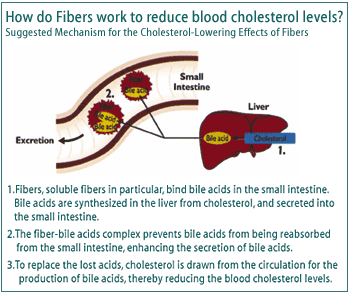|
What are the Benefits of a High Fiber Diet?
Do you know the many benefits of a high fiber diet? Do you know the difference between soluble fiber and insoluble fiber? What is fiber? Did you know that fiber is actually beneficial to most people with digestive system health challenges such as diverticulitis, diverticulosis, spastic colon, colitis and irritable bowel syndrome (IBS). Not too long ago, it was believed that a low fiber diet was best for people with colon diseases. But now the medical community is recommending a high fiber diet. The secret is to introduce the fiber gradually, until you reach the proper daily amounts (25-30 grams). For some with digestion system disorders, this fiber increase may occur over a few days, but more than likely it may take a few weeks to reach that level. If you start to have a challenge, reduce the amount of fiber you are taking until it feels comfortable again. Then gradually introduce a larger amount until you reach your goal.
Important things to know about Fiber

Fiber is a special type of carbohydrate that passes through the human digestive system virtually unchanged, without being broken down into nutrients. Fiber has a positive influence on the digestion process from start to finish. Fiber is found only in food that come from plants, including all-natural cereals, whole-grain breads, beans, fruits, vegetables, and nuts. Your diet should contain approximately 25 to 30 grams of fiber each and every day, but the average American eats less than half of that. LESS THAN HALF!!! If you don't believe that is true, try taking the Eating Challenge. Click on the "CHALLENGE" navigational button and see how you do. Fiber helps relieve various health issues such as constipation and hemorrhoids. Fiber can help keep weight under control, and can help prevent certain diseases such as heart disease, cancer, diabetes, diverticular disease, gallstones, and kidney stones. Fiber keeps stool soft and keeps the contents of the intestines moving. Americans consume only about 10% of the fiber that they did 100 years ago. One of the main reasons our diets are so fiber deficient is because of the change in the way wheat was processed into flour at the turn of the century-from a crushing to a finer rolling process. Bran has the highest fiber content - about 25% to 45%. One of the leading manufacturers of fiber products has created an information web site that provides more detail about fiber the reasons why our bodies need the 25-25 grams daily. That site contains statistics, diagrams, and a question and answer segment that you may find helpful in your understanding of the benefits of fiber. The site also contains a culmination of information from the American Journal of Cardiology, the U.S. Food and Drug Administration (FDA), and the American Dietetic Association. To read what the research concludes,
Click Here. Did you know that ingesting the right matrix of fiber, mostly containing soluble fiber, can help balance your blood sugar and improve your cholesterol? It's true! Fiber slows digestion and absorption so that glucose (sugar) in food enters the bloodstream more slowly, which keeps blood sugar on a more even level. It's not magic. It's science.
The Food and Drug Administration (FDA) recognizes the importance of a high fiber diet by requiring the amount of fiber to be listed on the Nutrition Facts panel of food labels along with other key nutrients and calories. In fact, based on scientific evidence, the agency has approved four health claims related to daily high fiber intake and lowered risk of heart disease and cancer.
• Diets low in fat and rich in fiber-containing grain products, fruits and vegetables may reduce the risk of some types of cancer, a disease associated with many factors (§101.76). • Diets low in saturated fat and cholesterol and rich in fruits, vegetables and grain products that contain some types of dietary fiber, particularly soluble fiber, may reduce the risk of coronary heart disease, a disease associated with many factors (§101.77). • Diets low in fat and rich in fruits and vegetables, which are low-fat foods and may contain fiber, vitamin A and vitamin C, may reduce the risk of some types of cancer (§101.78). • Diets low in saturated fat and cholesterol that include 3 grams or more of soluble fiber from oats per day may reduce the risk of heart disease (§101.81). Do you currently have a high fiber diet? What are you doing to ensure you are getting enough of the fiber you need? Want an easy and effective method to get the fiber you need? Look to a pharmaceutical grade fiber product. Possibly the best high fiber product on the market is "Bios Life 2". It is a pharmaceutical grade, high quality fiber product developed at Stanford University by research scientists, tested at the world-renowned Cleveland Clinic, manufactured by the 100-year-old Rexall company, and distributed by Unicity. Interestingly enough, the research scientist at Stanford University were attempting to develop a product for diabetics. While they were successful in doing so, the product they developed also has proven to reduce cholestorol and benefit people with digestive disorders like diverticulitis and diverticulosis. "Bios Life 2" is under 2 U.S. patents and is listed in the Physician's Desk Reference (PDR). Help yourself to this
high fiber Prescription For Life!
|

